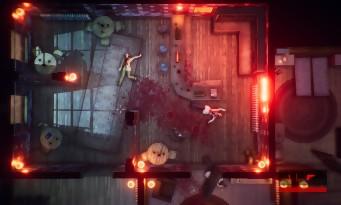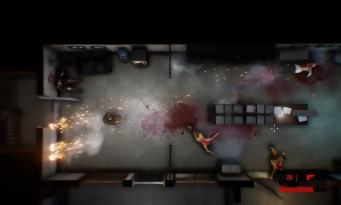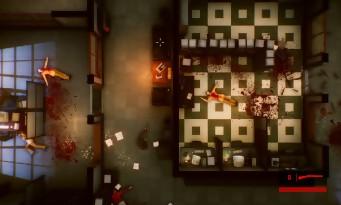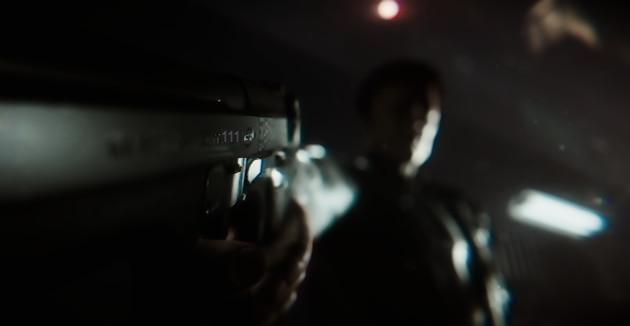 The events of the game take place in Hong Kong between June 10 and 14, 1992. A former local police detective strings together murders to get revenge on the triads. And that's about it ! If the game has a scenario and tries some staging effects, it is actually satisfied with the bare minimum in this area. The cutscenes between each chapter never exceed ten seconds, and the rare non-interactive dialogue sequences hardly last longer. In short, it is not for its scenario that you will play Hong Kong Massacre, but for its gameplay and its atmosphere. The latter takes up all the clichés that are generally associated with John Woo's films, which is rather a good thing. Cop against mafia, omnipresence of firearms, uninhibited violence, sheaves of blood, nightlife, and decorations made up of apartments, alleys, restaurants and other cocaine laboratories instantly plunge us into the atmosphere of organized crime in Hong Kong. Lanterns, neon lights, bluish or orange colors... if you've ever played Sleeping Dogs, you won't be out of place. Moreover, even if The Hong Kong Massacre is an independent game in top view, it frees itself from retro fashion and large pixels like Hotline Miami to favor 3D graphics much more in tune with our times. The camera located high up and the studio's certainly limited budget inevitably limit the technical prowess, but the environments remain very correctly detailed, while the diffuse lighting, the destructibility of certain elements of the decor, and the particle effects ensure the show, in particular during slowdowns. The only technical-artistic downside concerns the camera shot that marks the end of each level. To underline that we have just killed the last enemy in the area, the game gives us a view from human height and a nice slow motion effect, but this shot is systematically bathed in a huge blur, which comes spoil much of this small visual reward.
The events of the game take place in Hong Kong between June 10 and 14, 1992. A former local police detective strings together murders to get revenge on the triads. And that's about it ! If the game has a scenario and tries some staging effects, it is actually satisfied with the bare minimum in this area. The cutscenes between each chapter never exceed ten seconds, and the rare non-interactive dialogue sequences hardly last longer. In short, it is not for its scenario that you will play Hong Kong Massacre, but for its gameplay and its atmosphere. The latter takes up all the clichés that are generally associated with John Woo's films, which is rather a good thing. Cop against mafia, omnipresence of firearms, uninhibited violence, sheaves of blood, nightlife, and decorations made up of apartments, alleys, restaurants and other cocaine laboratories instantly plunge us into the atmosphere of organized crime in Hong Kong. Lanterns, neon lights, bluish or orange colors... if you've ever played Sleeping Dogs, you won't be out of place. Moreover, even if The Hong Kong Massacre is an independent game in top view, it frees itself from retro fashion and large pixels like Hotline Miami to favor 3D graphics much more in tune with our times. The camera located high up and the studio's certainly limited budget inevitably limit the technical prowess, but the environments remain very correctly detailed, while the diffuse lighting, the destructibility of certain elements of the decor, and the particle effects ensure the show, in particular during slowdowns. The only technical-artistic downside concerns the camera shot that marks the end of each level. To underline that we have just killed the last enemy in the area, the game gives us a view from human height and a nice slow motion effect, but this shot is systematically bathed in a huge blur, which comes spoil much of this small visual reward.
HARD BOILED
 Without any concessions regarding the health of the player, The Hong Kong Massacre will show you a game over screen at the slightest ball received. Suffice to say that the "die & retry" aspect is very high, and that you will generally need several tries before overcoming a level. Remembering enemy positioning and level architecture is usually crucial to coming out on top in gunfights. However, the game is very far from insurmountable. First of all, it is possible to improve the four weapons at our disposal, thanks to stars earned by progressing in the campaign. The pistol, rifle, shotgun and submachine gun can thus gain in ammunition capacity, firing speed or reloading speed. Knowing that you can pick up the weapon from any downed enemy, it's important to level up the entire arsenal as much as possible. But the best way to get out of the most delicate situations is to draw the two "powers" of the hero. The first of them is a real bullet-time that dear Max Payne would not deny. The action is then greatly slowed down, which allows both better placement of bullets and easier avoidance of enemy fire. The second ability is a dive which makes you virtually invincible, since it allows you to dodge absolutely all bullets. In addition, it is possible to engage the two options simultaneously, which largely compensates for the fact of dying instantly as soon as one is hit.
Without any concessions regarding the health of the player, The Hong Kong Massacre will show you a game over screen at the slightest ball received. Suffice to say that the "die & retry" aspect is very high, and that you will generally need several tries before overcoming a level. Remembering enemy positioning and level architecture is usually crucial to coming out on top in gunfights. However, the game is very far from insurmountable. First of all, it is possible to improve the four weapons at our disposal, thanks to stars earned by progressing in the campaign. The pistol, rifle, shotgun and submachine gun can thus gain in ammunition capacity, firing speed or reloading speed. Knowing that you can pick up the weapon from any downed enemy, it's important to level up the entire arsenal as much as possible. But the best way to get out of the most delicate situations is to draw the two "powers" of the hero. The first of them is a real bullet-time that dear Max Payne would not deny. The action is then greatly slowed down, which allows both better placement of bullets and easier avoidance of enemy fire. The second ability is a dive which makes you virtually invincible, since it allows you to dodge absolutely all bullets. In addition, it is possible to engage the two options simultaneously, which largely compensates for the fact of dying instantly as soon as one is hit.
HOTLINE HK
 Moreover, apart from a few particularly difficult passages, the game is not as difficult as it looks, since we abuse the slow motion and the dive. A better compromise between game pleasure and difficulty could surely have been found by the developers, in particular by limiting the use of these two overpowered capacities. But the main flaw of the game comes from its very repetitive aspect. It's very simple, you have to wait two-thirds of the campaign to have the first and only variation of gameplay appear, namely the appearance of enemies dressed in bulletproof vests. These opponents, a little tougher than the others, get up after the first ball received, and it takes a second to make them go from life to death for good. The Hong Kong Massacre also tries to surprise the player with boss sequences that are slightly different from the basic gameplay, but the five fights that punctuate the five chapters of the adventure take place in the same way (progression on parallel roofs and presence of a life bar for the boss). The lack of variety associated with the overpowering of the hero's abilities means that we quickly take the fold and that one evening is enough to complete the campaign. The replayability then comes from the challenges, which allow you to earn three additional stars per level (by finishing it in less than a certain time, by not using slow motion, and/or by ensuring that each bullet fired hits an enemy). ). In the end, The Hong Kong Massacre is therefore more aimed at players who like to complete challenges in a loop than at those who favor varied and highly scripted action.
Moreover, apart from a few particularly difficult passages, the game is not as difficult as it looks, since we abuse the slow motion and the dive. A better compromise between game pleasure and difficulty could surely have been found by the developers, in particular by limiting the use of these two overpowered capacities. But the main flaw of the game comes from its very repetitive aspect. It's very simple, you have to wait two-thirds of the campaign to have the first and only variation of gameplay appear, namely the appearance of enemies dressed in bulletproof vests. These opponents, a little tougher than the others, get up after the first ball received, and it takes a second to make them go from life to death for good. The Hong Kong Massacre also tries to surprise the player with boss sequences that are slightly different from the basic gameplay, but the five fights that punctuate the five chapters of the adventure take place in the same way (progression on parallel roofs and presence of a life bar for the boss). The lack of variety associated with the overpowering of the hero's abilities means that we quickly take the fold and that one evening is enough to complete the campaign. The replayability then comes from the challenges, which allow you to earn three additional stars per level (by finishing it in less than a certain time, by not using slow motion, and/or by ensuring that each bullet fired hits an enemy). ). In the end, The Hong Kong Massacre is therefore more aimed at players who like to complete challenges in a loop than at those who favor varied and highly scripted action.


























